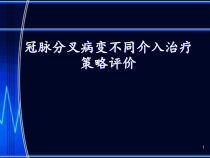 PPT
PPT
【文档说明】冠脉分叉病变不同介入治疗策略评价课件.ppt,共(48)页,1.923 MB,由小橙橙上传
转载请保留链接:https://www.ichengzhen.cn/view-248592.html
以下为本文档部分文字说明:
冠脉分叉病变不同介入治疗策略评价1•Accountfor15-20%ofPCI•Whyanindivdualizedapproach?–VariationsinAnatomy•Leftmainbifurcationdisease•Plaqueburden&locationofplaque•A
nglebetweenMBandSB–Dynamicchangesinanatomyduringtreatment•Plaqueshift•DissectionNotwobifurcationsareidentical•Anappropriatestrategyfromtheoutse
tsavestimeandminimizescomplicationBifurcationPCI2分叉病变分型DukeClassificationSanbornClassificationIakovouI,GeL,ColomboA.JACC,2
005;46:1446-1455.3SafianClassificationIakovouI,GeL,ColomboA.JACC,2005;46:1446-1455.4LefevreClassificationIakovouI,GeL,ColomboA.JACC,2005
;46:1446-1455.5MedinaClassificationMedinaetal.RevEspCardiol.2006;59(2):183-4.6分叉病变介入治疗策略单支架二个支架7单个支架或二个支架?A)如果分支血管的开口部位或其附近有明显的病变,其血管直径足够大,从
安全性和PCI的疗效来考虑应该置入两个支架。B)在其他情况下,应置入一个支架andthenevaluate当前,大家公认和使用的分叉病变治疗策略是分支血管Provisional支架术。然而仍有许多分支血管其解剖结构(直径较大,病变较为弥漫)需要置入两个支架。8WhatTypeofBif
urcationsareCommonlyTreated?•Majority(65%)are“True”bifurcations•ExtentofSBdiseasemaydeterminestrateg
y•Non-LMBifstreatedinMilan(n=320).ExtentofSBdisease:–018%–<5mm27%–5-10mm19%–>10mm36%9分叉病变介入治疗技术1.分支血管通畅技术(KIO)2.必要时置入第二个支架(P
rovisional2ndstent)3.双支架术10分支血管通畅技术(KIO)当分支血管开口病变或弥漫性病变,并且分支血管不适合置入支架时(太细小)或者分支血管和临床症状不相关时⚫主支和分支血管分别放入导引钢丝⚫如果需要扩张主支血管⚫主支血管置入支架,分支血管保留导引钢丝⚫后扩张主支血
管,分支血管保留受压的导引钢丝不要再次把导引钢丝放入分支血管或者后扩张或预扩张分支血管11Provisional支架当分支血管病变程度极轻或者病变仅位于分支血管开口处并且分支血管解剖结构适合置入支架者⚫主支和分支血管放入导引钢丝⚫扩张主支血管,必要时扩张分支血管⚫主支血管置入支架,分支血
管保留导引钢丝⚫分支血管再次放入导引钢丝,然后撤出受压的原导引钢丝⚫球囊对吻⚫如果分支血管出现次佳结果则在分支血管置入支架(T支架术或ReverseCrush)12保护分支血管术前冠脉造影前降支-对角支病变前降支置入支架Xience3.0x28mm13支架术后对
角支POBA球囊3.0x20mm前降支-对角支病变14最终结果15Wirebothbranchesandpre-dilatethemainandthesidebranchasrequired.Step1:
StenttheMBjailingtheSBwireIftheresultinSBunsatisfactoryduetoplaqueshiftordissectionandSBhastobestented,thenre-crossintotheSBthroughtheMBstentstrutsS
tep2:TheT-stentingwithProtrusionTechnique(TAP)asaCross-overfromtheProvisionalApproach16PositionstentinSBen
suringcoverageofostiumwithminimalprotrusionintoMBandplacenon-compliantballooninMBstentFinalResult:InflatethedeliveryballoonintheSBandtheMBballoonsimu
ltaneouslyStep3:Step4:TheT-stentingwithProtrusionTechnique(TAP)asaCross-overfromtheProvisionalApproach171:Rewire
sidebranchandadvanceaballoonanddilatetowardSB2:PositionastentintheSBwithminimalprotrusionintheMB.Leaveaballooninthe
MBEVALUATERESULT:iftheresultisnotacceptablethenAReverseCrushStenting183:DeploythestentintheSBandremovethewireandtheballoon4:Crushtheshortprotr
udingpartofSBstentoverthestentinMBbyinflatingtheMBballoonBReverseCrushStenting195:RewiretheSBandperformhighpressuredila
tation6:PerformfinalkissingballooninflationCReverseCrushStenting双支架术当分支血管的病变比较弥漫,不仅仅局限于分支开口部位,并且分支血管适合置入支架1.主支和分支血管
放入导引钢丝2.扩张主支血管,必要时扩张分支血管3.Crush支架术或其他双支架术4.如果进行Crush:分支血管再次放入导引钢丝,对其进行高压球囊扩张5.球囊对吻扩张21Crush支架术•标准Crush:7F以
上指引导管,事先对两个支架定位,然后释放分支血管支架,主支血管支架挤压分支血管支架•Reverse(Internal)Crush:行Provisional支架术时需要在分支血管置入另一个支架时采用。6F指引导管,
首先释放主支血管支架,通过主支支架的侧孔置入分支血管支架,通过预留在主支的球囊对分支血管支架进行挤压•InverseCrush:操作过程类似标准Crush支架术,但是分支血管的支架定位比主支血管更为近端,分支血管的支架去挤压主支血管支架•StepCrush:与标准Crush技术相同,但可在6F指
引导管进行22StentingTechniquesfortheTreatmentBifurcationLesionsLouvardY,LefevreT,MoriceMC,etal,Heart2004;90:713-22ClassicTbeginningSBM
odifiedTCrushClassicTbeginningMBProvisionTCullotteTouchingstentsTrouserlegsandseatKissingstentsSkirttechnique23分叉病变包括左主干病变的治疗方法真性分
叉病变(主支和分支血管明显狭窄)非是主支血管置入支架,分支血管进行球囊扩张分支血管适合支架术分支血管病变,从开口向远端弥漫超过3mm以上选择性置入两个支架(主支和分支)分支血管Provisional支架术分支血管Provisional支架术或KIO非是非
是24•绝大多数分叉病变在介入治疗结束时需要保持分支血管通畅,残余狭窄似乎意义不大•如果分支血管达到最佳结果比较重要,在真性分叉病变中至少有50%的患者需要置入两个支架分叉病变总结1支架策略只有临床需要才进行冠脉造影随访25
BMSera:Onestentisbetter!010203040AnzuiniAlSuwaidiPanSheibanLefèvreAssali1stent2stents2617.7%12.7%0%10%20%MV+SBgroupM
VgroupEnd-pointat6months(%)p=NSNORDICBifurcationStudySteigenTKetal.Cir,2006,114:1955-61.27MACEat6months(%)p=NS1
.2%1.8%2.4%1.2%0.6%2.3%0%1%2%3%6monthcardiacdeathClinicalMITLRMV+SBgroupMVgroupNORDICBifurcationStudySteigenTKetal.Cir,20
06,114:1955-61.2813%4%0%5%10%15%MV+SBgroupMVgroupMIrelatedtotheprocedure(%)p=0.008NORDICBifurcationStudyS
teigenTKetal.Cir,2006,114:1955-61.291.2%0.6%0.0%0.5%1.0%1.5%MV+SBgroupMVgroupStentThrombosis(%)p=NSNORDICBifurcationStudySteigenTKetal.Cir,2006,11
4:1955-61.30NordicStentTechniqueStudyARandomizedStudyofCrushvs.CulotteStentTechniqueswithSirolimusElutingStentsinBifurcationLesionsErglisAe
tal.CircCardiovascIntervent,2009;2:27-34Crush(n=209)Culotte(n=215)PvalueMACE4.3%3.7%0.87Procedure-relatedBio-markersincrease15.5%8.8%0.08Insegme
ntRestenosis12.1%6.6%0.10InstentRestenosis10.5%4.5%0.046NordicII:31NordicIII:AProspectiveRandomizedTrialofS
ideBranchDilatationStrategiesinPatientswithCoronaryBifurcationLesionsUndergoingTreatmentwithaSingleStent0
123456NOKISSINGKISSING%2.92.9PrimaryendpointMACE(cardiacdeath,indexlesionMI,TLR,stentthrombosis)after6monthsnsNiemelaM.TCT200932BBCON
EStudyPRIMARYENDPOINTComposite(9months)Death,MI,TVFSimpleComplexPvalueDeath0.4%0.8%-Myocardialinfarc
tion3.6%11.2%0.001Targetvesselfailure5.6%7.2%0.43Primaryendpoint8.0%15.2%0.009HR2.02(1.17to3.47)DavidHildick-Smithetal.C
ir2010;121:1235-124333BBCONEStudyPROCEDURALENDPOINTSimpleComplexPvalueProcedureTime,min5778<0.001Fluoroscop
yTime,min1522<0.001Diamentor,cGy-cm261407900<0.001No.ofGuidewiresUsed2.23.1<0.001No.ofBalloonUsed2.34.0<0.001No.ofStentsUs
ed1.22.2<0.001DavidHildick-Smithetal.Cir2010;121:1235-124334*OnenoncardiacdeathduetoischemicstrokeCACTUSStudy(CoronaryBi
furcations:ApplicationoftheCrushingTechniqueUsingSirolimus-ElutingStents)ColomboA,etal.Circulation.2009;119(1):71-8EndpointCrush(%)Provisiona
lT(%)Main-branchbinarystenosis4.66.7Side-branchbinaryrestenosis13.214.7MI0.50.5TLR5.65.8TVR6.26.8Dea
th00.5*Stentthrombosis1.71.135InfluenceofFinalKissingintheCACTUStrialColomboA,etal.Circulation.2009;119(1):71-8Endpo
intFinalKissing(163pts)NoFinalKissing(14pts)PvalueMain-branchstenosis4.7%16%0.03Side-branchrestenosis
11.9%36%0.001MI7.5%29%0.001TLR6.3%12.9%0.25Stentthrombosis0.9%6.5%0.06360.60.40.2MainBranchSideBranch051015202530354015.5%(9/58)8.9%(8/90
)37.9%(22/58)11.1%(10/90)0.210.34P=0.10P<0.05P=0.33P<0.001Restenosis(%)LLL(mm)0.320.52ImportantRoleoffinalkissingballoo
ninCrushTechniqueGeL,etal.JACC,2005;46:613-620.WithoutFKBFKB37Kissme,Kate!9MonthClinicalOutcomesAfter
CrushStentingGeL,etal.JACC,2005;46:613-620.38T-stenting(n=61)Crushingstenting(n=121)T-StentingVS.Crushin
gStenting14.0%TLRTVRTLRTVR31.1%16.5%32.8%14.1%11.3%28.9%31.1%ENTIRECOHORT05101520253035KISSINGBALLOONP=0.01P=0.02P=0.03P=0.04
GeL,etal.Heart,2006;92:371-376GeL,etal.Heart,2006;92:371-37639MiniCrushwithDoubleKissingJIMMH,etal.CCI,2007,69:969-97540
Non-randomizedcomparison;457patientswithbifurcationdiseaseGalassiAR,etal.JAmCollCardiolIntv.2009;2:185-194.Mini-Crushvs.T-Provision
alTechniquesofDESImplantationinBifurcationLesions2-StentMini-CrushN=199T-Provisional1StentN=170T-Provisional2Sten
tsN=88MI2.0%5.8%26.1%StentThrombosisBifurcationTLR8.5%14.5%17.4%MVRestenosis11.7%17.4%18.8%SBRestenosis8.5%1
8.8%26%KissingInflation88.2%83%52.2%41Double-KissingCrush:DKCRUSH-12-yearf/uCrushDKCrushpTLR23.4%11.
4%0.02MACE29.9%18.1%0.04ChenSetal,JIntervCardiol2009RCTin312patientsat12centersKissinginflationin76%ofclassicalcrushand100%ofDKCrush42
两步法对吻技术的重要性无对吻1步法对吻2步法对吻43STEPCRUSH技术步骤•先置入边支血管支架•放置边支支架同时主支内放置球囊,挤压边支支架(可进行第一次Kissing)•置入主支血管支架•导丝再次进入边支•最终完
成主支和分支的Kissing扩张44STEPCRUSH45464748
 辽公网安备 21102102000191号
辽公网安备 21102102000191号
 营业执照
营业执照